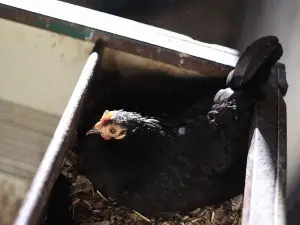
Chickens are not invincible, in fact, there are quite a number of illnesses and ailments that chickens can suffer from, one such ailment is bumblefoot.
If you notice that your chicken’s foot is swollen, but the bird does not have bumblefoot, then the bird may be suffering from something else, this article looks into it
Table of Contents
Chicken swollen foot, not bumblefoot:
Bumblefoot develops when an open wound under the bird’s foot, from a cut or scrape, becomes infected.
A black patch, called a bumble, will appear under your bird’s foot where the wound was and the bird’s foot will start to swell up.
As this ailment progresses, the foot becomes swollen as it fills with pus.
If your bird does not have a black patch under its foot, but the foot is still swollen, then your bird may have mycoplasma synoviae or an abscess on its foot.
Mycoplasma synoviae:
Mycoplasma synoviae is a disease that chickens can catch from other chickens. This disease can affect chickens, pigeons, geese, ducks, and home sparrows but it is most common in chickens and turkeys.
Mycoplasma synoviae is a bacterial disease that mother hens pass on to their young at the egg stage. The illness will cause swelling in parts of the bird’s body including the joints and the feet.
If your bird’s foot is swollen, and the bird doesn’t have bumblefoot, then the bird may have Mycoplasma synoviae.
100% of your flock may have this disease but only a few birds may show symptoms of it, like a swollen foot
Other signs and symptoms:
Other symptoms of this disease include:
- Swelling of the joints
- Pale combs
- Stunted growth
- Joint swelling
- Blisters
What to do:
If you think that your bird has this ailment then you’d need to get the bird to a vet where it will be tested, and diagnosed.
If your bird does in fact have this disease then the vet will prescribe antibiotics for your bird.
Be sure to only feed your bird the antibiotics prescribed to your pet by your vet. Giving your bird inappropriate antibiotics can cause the bird to develop antibiotic resistance
An abscess:
If your bird’s foot is swollen, and your bird does not have bumblefoot or Mycoplasma synoviae, then the bird may simply have an abscess on its foot.
Bumblefoot develops under the bird’s foot. If your bird’s injury happened on top of its foot then the bird’s open wound may have become infected and formed an abscess, causing it to swell up.
What to do:
If the bird does have an abscess on top of its foot then the abscess may break open one day and drain on its own.
Doing nothing and letting the bird’s body deal with the abscess may be the best way to deal with it.
If the abscess is not going away, and is badly infected, then you may need to treat it yourself. Taking the bird to the vet is preferred but you can also choose to lance the abscess yourself
If you choose to lance the abscess, make sure that you use a sharp knife, like an Exacto knife or a razor blade. Heat the knife or blade on the stove, over a fire, or, use alcohol to clean it before use.
Make sure that the bird’s skin is also cleaned before lancing, use antibacterial soap to do this.
Hold the bird in a blanket to keep it calm and then make a quarter-inch incision on the abscess and allow it to drain out. Apply some topical antibiotics to the area once it has drained.
Keep an eye on your bird after lancing, if the area becomes infected, take her to the vet.
FAQ:
What does gout look like in chickens?
Gout does not only affect humans, it affects other animals as well, animals like chickens. How gout shows up in chickens is also interesting
Gout in chickens shows up as swollen feet and joints, redness at the feet and joints, lethargy, dehydration, ruffled feathers and white chalky deposits of uric acid in different locations, like the joints or internal organs
How to tell if a chicken is in pain?
There are different behaviours that chickens will do when they are in pain, these include having a crouched posture, closing their eyes, droopy wings, ruffled feathers, and keeping their beak open while breathing
If you enjoyed this article then you may also be interested in other chicken related articles. Here are some articles that you may be interested in: Syringe Feeding A Chicken, Home Remedies For Chicken Pecking, Chickens Pecking Each Other Bloody, Can You Stop Chickens From Pecking Each Other Using Vinegar?, Pedialyte For Chickens,

